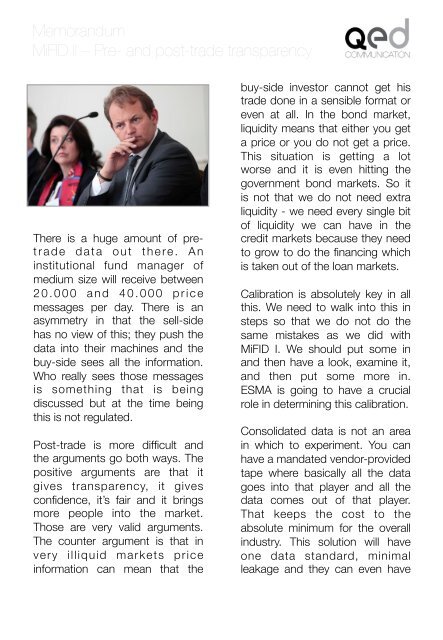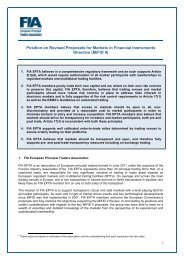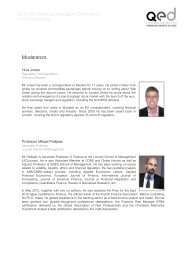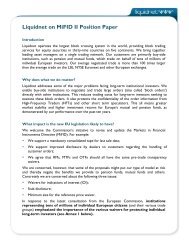MiFID II â Pre- and post- trade transparency - QED
MiFID II â Pre- and post- trade transparency - QED
MiFID II â Pre- and post- trade transparency - QED
You also want an ePaper? Increase the reach of your titles
YUMPU automatically turns print PDFs into web optimized ePapers that Google loves.
Memor<strong>and</strong>um<br />
<strong>MiFID</strong> <strong>II</strong> – <strong>Pre</strong>- <strong>and</strong> <strong>post</strong>-<strong>trade</strong> <strong>transparency</strong><br />
There is a huge amount of pret<br />
r a d e d a t a o u t t h e re . A n<br />
institutional fund manager of<br />
medium size will receive between<br />
2 0 . 0 0 0 a n d 4 0 . 0 0 0 p r i c e<br />
messages per day. There is an<br />
asymmetry in that the sell-side<br />
has no view of this; they push the<br />
data into their machines <strong>and</strong> the<br />
buy-side sees all the information.<br />
Who really sees those messages<br />
is something that is being<br />
discussed but at the time being<br />
this is not regulated. <br />
Post-<strong>trade</strong> is more difficult <strong>and</strong><br />
the arguments go both ways. The<br />
positive arguments are that it<br />
gives <strong>transparency</strong>, it gives<br />
confidence, it’s fair <strong>and</strong> it brings<br />
more people into the market.<br />
Those are very valid arguments.<br />
The counter argument is that in<br />
very illiquid markets price<br />
information can mean that the <br />
buy-side investor cannot get his<br />
<strong>trade</strong> done in a sensible format or<br />
even at all. In the bond market,<br />
liquidity means that either you get <br />
a price or you do not get a price.<br />
This situation is getting a lot<br />
worse <strong>and</strong> it is even hitting the<br />
government bond markets. So it<br />
is not that we do not need extra<br />
liquidity - we need every single bit<br />
of liquidity we can have in the <br />
credit markets because they need<br />
to grow to do the financing which<br />
is taken out of the loan markets. <br />
Calibration is absolutely key in all<br />
this. We need to walk into this in<br />
steps so that we do not do the<br />
same mistakes as we did with<br />
<strong>MiFID</strong> I. We should put some in<br />
<strong>and</strong> then have a look, examine it,<br />
<strong>and</strong> then put some more in.<br />
ESMA is going to have a crucial<br />
role in determining this calibration.<br />
Consolidated data is not an area<br />
in which to experiment. You can<br />
have a m<strong>and</strong>ated vendor-provided<br />
tape where basically all the data<br />
goes into that player <strong>and</strong> all the<br />
data comes out of that player.<br />
That keeps the cost to the<br />
absolute minimum for the overall<br />
industry. This solution will have<br />
one data st<strong>and</strong>ard, minimal<br />
leakage <strong>and</strong> they can even have










